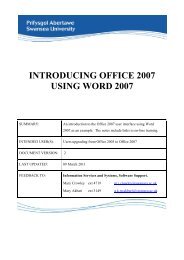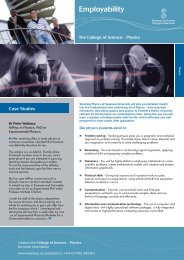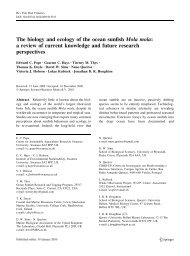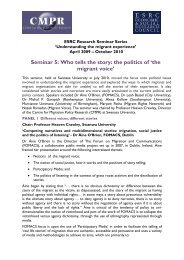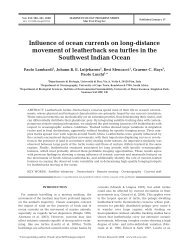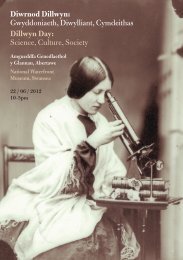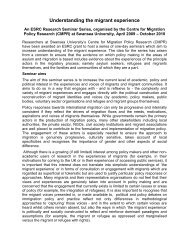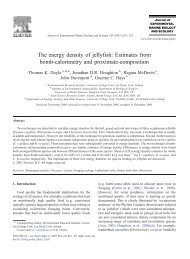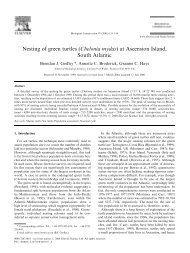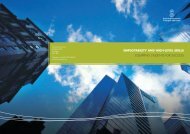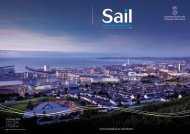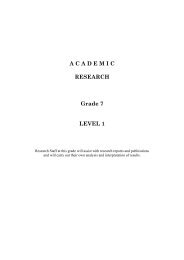You also want an ePaper? Increase the reach of your titles
YUMPU automatically turns print PDFs into web optimized ePapers that Google loves.
Research news<br />
Upping the anti<br />
Scientists at CERN in Geneva – including<br />
physicists from <strong>Swansea</strong> <strong>University</strong> – have<br />
succeeded in trapping antimatter atoms for<br />
over 16 minutes. The ALPHA (Anti-hydrogen<br />
Laser Physics Apparatus) team have created,<br />
trapped, and stored antihydrogen atoms long<br />
enough to begin to study them in detail. It is<br />
the longest time period that antihydrogen has<br />
been captured and a significant development<br />
on the experiment’s major advance last<br />
November, when atoms of antimatter were<br />
trapped for the first time.<br />
Controlled production of antihydrogen atoms<br />
in the laboratory has been possible for nearly<br />
a decade, when CERN’s ATHENA project, the<br />
first experiment to produce copious amounts of<br />
cold antihydrogen, made its first breakthrough.<br />
However, all of these anti-atoms were quickly<br />
annihilated when they came into contact with<br />
matter. This has now changed with the latest<br />
ALPHA breakthrough.<br />
The <strong>Swansea</strong> team, led by Professor<br />
Mike Charlton, played a major role in<br />
both the ATHENA and ALPHA projects.<br />
Professor Charlton said: “Our aim is to study<br />
antihydrogen, and make detailed comparisons<br />
with ordinary hydrogen. Whilst hydrogen is<br />
the most abundant element in the Universe, it<br />
seems that antihydrogen has only ever been<br />
formed in our experiments here on Earth.<br />
Why there was no antimatter left when the<br />
Universe became cold enough for atoms to<br />
form remains a great mystery – and one we<br />
hope to shed some light upon.”<br />
“This latest development is a huge step towards<br />
measurements on antihydrogen and we are<br />
planning first experiments for later in the year,”<br />
said <strong>Swansea</strong> <strong>University</strong> physicist Dr Niels<br />
Madsen, who is currently on sabbatical at<br />
CERN after winning a prestigious Royal Society<br />
Leverhulme Trust Senior Research Fellowship.<br />
“We have increased the efficiency with which<br />
we trap the antihydrogen atoms and held<br />
onto some of them for long periods, already<br />
increasing our capability several thousand<br />
times over what we reported last November.”<br />
Professor Mike Charlton<br />
Copperworks site link-up<br />
seeks to promote<br />
industrial heritage<br />
<strong>Swansea</strong> Council is entering into a<br />
Memorandum of Understanding with <strong>Swansea</strong><br />
<strong>University</strong> and will work with them as a<br />
preferred development partner to explore<br />
regeneration opportunities for the city’s<br />
historic Hafod Copperworks.<br />
A feasibility study will explore the potential to<br />
preserve and develop the historic buildings on<br />
the site, review the masterplan for the site and<br />
investigate sources of funding.<br />
The Hafod Copperworks site contains<br />
12 Grade II listed buildings and structures,<br />
an industrial heritage site of international<br />
importance that reflects <strong>Swansea</strong>’s development<br />
over the past 200 years.<br />
Professor Huw Bowen, who leads the project<br />
team on behalf of the <strong>University</strong>, said:<br />
“Exploring ways of developing the Hafod<br />
Copperworks site for the benefit of future<br />
generations offers us the chance – perhaps<br />
the last chance – of ensuring that visible signs<br />
of <strong>Swansea</strong>’s immensely important industrial<br />
achievements are not lost forever.<br />
It is now hoped that the heritage-led feasibility<br />
study can find ways of maximising the<br />
economic, social, and educational potential<br />
offered by the Hafod site.”<br />
Top right: The Engine Houses on the site of the former<br />
Hafod Copperworks site, credit: Huw Bowen<br />
Right: Hafod Copperworks 1957,<br />
image courtesy of City and County of <strong>Swansea</strong><br />
Fungus combats<br />
Bluetongue disease<br />
The <strong>University</strong>’s College of Science is home to<br />
one of the UK’s leading insect mycopathology<br />
(insect pest control) teams. Team member<br />
Dr Minshad Ali Ansari has recently conducted<br />
a study that shows for the first time that a<br />
fungus known as Metarhizium anisopliae<br />
V275 can effectively kill adult Culicoides<br />
(biting midges) in the family of insects<br />
that carry Bluetongue Virus (BTV).<br />
Bluetongue disease affects sheep and cattle. It<br />
has had a major economic impact in European<br />
countries in recent years. Control of the disease<br />
is becoming more important as the virus is<br />
starting to survive further north over winter.<br />
This study is particularly timely as new EU<br />
directives are encouraging member states<br />
to develop integrated pest management<br />
programmes which use benign plant protection<br />
products. Encouragingly, the efficiency of the<br />
fungus was shown to increase when applied<br />
to certain substrates such as manure,<br />
suggesting success in future field tests.<br />
Dr Ansari explained: “Although insecticides<br />
have proved effective in killing Culicoides<br />
species, they have been harmful to a range<br />
of beneficial insects.<br />
“As a result, the range of available insecticides<br />
has diminished as the chemical-based products<br />
are withdrawn from the market – because<br />
of the perceived risk to humans and the<br />
environment – and farmers face a growing<br />
challenge to control the population of<br />
biting midges.<br />
The fungi can, potentially, be applied<br />
cost-effectively to the places where adult<br />
midges rest, such as animal housing and<br />
livestock, to effectively target known<br />
problem areas.<br />
The next step is to test the fungus in large-scale<br />
field trials with the eventual aim of developing<br />
protocols for its simple and economical<br />
application in BTV endemic countries.”<br />
Healthy adult midges<br />
Why the sudden change?<br />
Dr Siwan Davies, Senior Lecturer in Geography,<br />
has been awarded a prestigious, £1.47 million<br />
European Research Council grant to unlock the<br />
secrets of past climate change. Microscopic<br />
layers of volcanic ash deposited in ancient ice<br />
and marine sediments will be examined with<br />
the research aiming to answer the key question<br />
of whether the ocean drives or merely amplifies<br />
atmospheric temperature jumps.<br />
Dr Davies said: “Little has challenged our<br />
understanding of climate change more than<br />
the abruptness with which large-scale jumps in<br />
temperature occurred in the past. The causes of<br />
these rapid climate changes that saw temperature<br />
swings of up to 16°C occurring within a few<br />
decades are poorly understood.<br />
These climatic events could be related to ocean<br />
circulation behaviour, or be triggered by changes<br />
in the atmosphere possibly in the tropics. This<br />
project will test these opposing possibilities through<br />
the analysis of microscopic layers of volcanic<br />
ash that have been deposited in ancient ice<br />
and marine sediments.”<br />
Dr Davies will build a new team who will employ<br />
a pioneering approach, using the microscopic<br />
traces of ash left from volcanic eruptions to precisely<br />
match Greenland ice-cores, which provide a<br />
record of atmospheric variability, with North<br />
Atlantic marine records, depicting changes in<br />
the ocean circulation system.<br />
Dr Siwan Davies helping with camp chores<br />
during fieldwork in Greenland in 2009:<br />
collecting snow to be used for drinking water.<br />
In brief<br />
<strong>Swansea</strong> <strong>University</strong> scientists are working with<br />
the Institute of Biological, Environmental and Rural<br />
Sciences at Aberystwyth <strong>University</strong> and collaborators<br />
at Bangor <strong>University</strong> on the £20 million BEACON<br />
project, a Welsh Government-funded initiative which<br />
aims to pioneer bio-refining using plant material<br />
or ‘bio-mass’ to dramatically reduce the world’s<br />
dependence on oil.<br />
A Coping with destitution report released in February<br />
by Oxfam and the <strong>University</strong>’s Centre for Migration<br />
Policy Research, paints a depressing picture of daily<br />
life for people seeking asylum in the UK. The report’s<br />
lead author, Professor Heaven Crawley, said: “This<br />
research gives us a rare insight into what life is like<br />
for refused asylum-seekers in the UK and shows<br />
that there is a deep-rooted lack of faith in the<br />
current system.”<br />
The National Geographic Channel’s Great<br />
Migrations series was made possible with the<br />
expertise of a team of researchers led by the<br />
<strong>University</strong>’s Rory Wilson, Professor of Aquatic<br />
Biology. Filming for the series involved using some<br />
of the <strong>Swansea</strong> Smart Tag Group’s revolutionary<br />
electronic logging tags, to track and analyse the<br />
behaviour of marine animals round the globe.<br />
For further information about the world-class<br />
research underway at <strong>Swansea</strong> <strong>University</strong>,<br />
visit www.swansea.ac.uk/research<br />
<strong>Sail</strong> – 02<br />
<strong>Sail</strong> – 03



